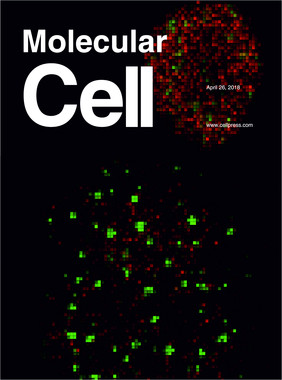
Figure: In this tentative issue cover, a graphical illustration of super-resolution images of a “young” (proliferating; top) and an “old” (senescent; bottom) cell nucleus is shown. In the “young” nucleus HMGB2 (red signal) is intertwined with CTCF signal (green). However, in the “old” nucleus HMGB2 is essentially absent and CTCF now clusters into large foci containing multiple protein copies and rearranging chromosomes.
The human genome is much more than a mere repository of genetic information. Over the last decade we have come to understand that the three-dimensional architecture of chromosomes is important for proper gene expression and cell function. However, both the expression of genes and the functionality of cells is dramatically impacted upon cellular ageing, and we have had little appreciation of how 3D genome architecture might be involved in this.
To address this, the research team led by Argyris Papantonis, a Junior Research Group at the Center for Molecular Medicine Cologne, studied the molecular mechanisms that drive human cells into senescence – an irreversible state in which cells cease to divide. Senescent cells are critical contributors to organismal ageing, and understanding their establishment is becoming increasingly pertinent.
For their recent work, published in the latest issue of Molecular Cell, one of the most respected molecular biology journals, Dr. Papantonis and his colleagues from Cologne (the Cologne Center for Genomics led by Peter Nurnberg and the lab of Roland Ullrich), Heidelberg (the lab of Karsten Rippe), Mainz (the lab of Vassilis Roukos), and Edinburgh (the lab of Davide Marenduzzo) combined cutting-edge genomics with single-cell studies and computational modeling to dissect the early events that lead a cell into senescence.
They found that a chromatin-binding protein called HMGB2 critically contributes to the 3D architecture of chromosomes, and that its loss constitutes the first step for senescence entry. This has a profound effect on the distribution of the established chromatin organizer CTCF that, in the absence of HMGB2, clusters into very large foci and leads to changes in the gene expression potential of these cells.
An important aspect of this work is that this early “CTCF-clustering” phenotype is reversible upon reintroduction of HMGB2, thus implying that this is a physiological step at which intervention might be possible to avert or delay senescence establishment. Now, in a next step, the team of Dr. Papantonis is exploring small molecule inhibitors that can modulate this effect in human cells.
Original Publication
Zirkel A*, Nikolic M*, Sofiadis K*, Mallm PJ, Brackley CA, Gothe H, Dreschel O, Becker C, Altmüller J, Josipovic N, Georgomanolis T, Brant L, Franzen J, Kokker M, Gusmao EG, Costa IG, Ullrich RT, Wagner W, Roukos V, Nürnberg P, Marenduzzo D, Rippe K, Papantonis A. Topological demarcation by HMGB2 is disrupted early upon senescence entry and induces CTCF clustering across cell types. Mol Cell (2018) doi: doi.org/10.1016/j.molcel.2018.03.030 (*equal contribution)
Contact
Dr. Argyris Papantonis
Junior Research Group Leader in Systems Biology
Center for Molecular Medicine Cologne
University of Cologne